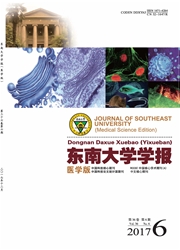

 中文摘要:
中文摘要:
当与某些化疗在联合使用了时, curcumin 被显示了在几根癌症房间线增加 apoptosis。这里,我们在人的颈的癌房间上报导 curcumin 和 cinobufacini 的联合效果。这研究的目的是检验 curcumin 是否能提高 cinobufacini 导致的 apoptosis。3-(4,5-Dimethylthiazol-2-y1 )-2,5-diphenytetrazolium 溴化物(MTT ) 试金表明 HeLa 房间的生长和增长能被 75% 在 25 g/mL cinobufacini 和 8 g/mL curcumin 的联合治疗以后禁止。联合治疗独自是比有 25 g/mL cinobufacini 的治疗更有效的 3 次。当房间也暴露于 curcumin 时,染色的 Annexin V-FITC/PI,词法变化和 immunofluorescence 在导致 cinobufacini 的 apoptosis 验证了重要改进。数据证明早 apoptotic 房间的比例显著地在在与 25 g/mL cinobufacini 和 8 g/mL curcumin 对待的房间仅仅与 25 g/mL cinobufacini 对待到 49.2% 的房间从 15.43% 增加了。而且与 25 仅仅 g/mL cinobufacini 的处理相比, ROS 生产增加了 1.7 褶层,细胞内部的免费 Ca2+ 集中增加了 1.5 褶层,和 mitochondrial 膜潜力在联合处理在 20% 减少了。同时,原子力量显微镜学(AFM ) 结果建议与 cinobufacini 和 curcumin 的联合对待的房间在形状和超微结构显著地变化了。有漏细胞质, blebbing 毛孔和新兴的 apoptotic 身体的折叠房间是流行的。当当房间与 25 g/mL cinobufacini 和 8 g/mL curcumin 被对待时,房间与 25 g/mL cinobufacini 被对待到 190 nm 时, nanoparticle 尺寸从 70 nm 增加了。尺寸增加导致了变得更加不平的房间膜。这些结果能改进我们联合处理的理解。明确地, cinobufacini 和 curcumin 的联合可以潜在地作为新奇的颈的癌治疗发现使用。另外, AFM 是能被用来探索细胞的形态学和超微结构的一个强大的工具。
 英文摘要:
英文摘要:
When used in combination with certain chemotherapies, curcumin has been shown to increase apoptosis in several cancer cell lines. Here, we report the combined effects of curcumin and cinobufacini on human cervical carcinoma ceils. The aim of this study was to examine whether curcumin could enhance apoptosis induced by cinobufacini. 3-(4,5-Dimethylthiazol-2-yl)-2,5- diphenytetrazolium bromide (MTT) assays revealed that the growth and proliferation of HeLa cells could be inhibited by 75% after a combined treatment of 25 μg/mL cinobufacini and 8μ g/mL curcumin. The combined treatment is 3 times more effective than treatment with 25 μg/mL cinobufacini alone. Annexin V-FITC/PI staining, morphological changes and immunofluorescence verified a significant enhancement in cinobufacini-induced apoptosis when ceils were also exposed to curcumin. The data showed that the proportion of early apoptotic cells significantly increased from 15.43% in cells treated only with 25μg/mL cinobufacini to 49.2% in ceils treated with 25 μg/mL cinobufacini and 8 μg/mL curcumin. Moreover, compared with treatment of only 25 μg/mL cinobufacini, ROS production increased 1.7-fold, the intracellular free Ca2+ concentration increased 1.5-fold, and the mitochon- drial membrane potential decreased by 20% in the combined treatment. Simultaneously, the atomic force microscopy (AFM) re- sults suggest that cells treated with a combination of cinobufacini and curcumin varied significantly in shape and ultrastructure. Collapsed cells with leaking cytoplasm, blebbing pores and emerging apoptotic bodies were prevalent. The nanoparticle size in- creased from 70 nm when the cells were treated with 25 μg/mL cinobufacini to 190 nm when the cells were treated with 25 μg/mL cinobufacini and 8 μg/mL curcumin. The size increase resulted in the cell membrane becoming considerably rough. These results can improve our understanding of combination treatments. Specifically, the combination of cinobufacini and curcumin may po- tentially find use a
 同期刊论文项目
同期刊论文项目
 同项目期刊论文
同项目期刊论文
 Tim-3-Expressing CD4(+) and CD8(+) T Cells in Human Tuberculosis (TB) Exhibit Polarized Effector Mem
Tim-3-Expressing CD4(+) and CD8(+) T Cells in Human Tuberculosis (TB) Exhibit Polarized Effector Mem Depletion of IL-22 during culture enhanced antigen-driven IFN-γ production by CD4+T cells from patie
Depletion of IL-22 during culture enhanced antigen-driven IFN-γ production by CD4+T cells from patie Selenium nanoparticles induced membrane bio-mechanical property changes in MCF-7 cells by disturbing
Selenium nanoparticles induced membrane bio-mechanical property changes in MCF-7 cells by disturbing Detection of lipopolysaccharide induced inflammatory responses inRAW264.7 macrophages using atomic f
Detection of lipopolysaccharide induced inflammatory responses inRAW264.7 macrophages using atomic f Preparation and characterization of nano-hydroxyapatite/chitosan composite with enhanced compressive
Preparation and characterization of nano-hydroxyapatite/chitosan composite with enhanced compressive A novel gold nanoparticle-doped polyaniline nano?bers-based cytosensor confers simple and ef?cient e
A novel gold nanoparticle-doped polyaniline nano?bers-based cytosensor confers simple and ef?cient e In situ single molecule detection of insulin receptors on erythrocytes from a type 1 diabetes ketoac
In situ single molecule detection of insulin receptors on erythrocytes from a type 1 diabetes ketoac In situ single molecule imaging of cell membranes: linking basic nanotechniques to cell biology, imm
In situ single molecule imaging of cell membranes: linking basic nanotechniques to cell biology, imm Photoinactivation effects of hematoporphyrin monomethyl ether on Gram-positive and -negative bacteri
Photoinactivation effects of hematoporphyrin monomethyl ether on Gram-positive and -negative bacteri Atomic Force Microscope-Related Study Membrane-Associated Cytotoxicity in Human Pterygium Fibroblast
Atomic Force Microscope-Related Study Membrane-Associated Cytotoxicity in Human Pterygium Fibroblast Sonodynamic Effects of Hematoporphyrin Monomethyl Ether on CNE-2 Cells Detected by Atomic Force Micr
Sonodynamic Effects of Hematoporphyrin Monomethyl Ether on CNE-2 Cells Detected by Atomic Force Micr Detection of erythrocytes in patient with elliptocytosis complicating ITP using atomic force microsc
Detection of erythrocytes in patient with elliptocytosis complicating ITP using atomic force microsc Curcumin induced nanoscale CD44 molecular redistribution and antigen-antibody interaction on HepG2 c
Curcumin induced nanoscale CD44 molecular redistribution and antigen-antibody interaction on HepG2 c An easy method to detect the kinetics of CD44 antibody and its receptors on B16 cells using atomic f
An easy method to detect the kinetics of CD44 antibody and its receptors on B16 cells using atomic f AFM- and NSOM-based force spectroscopy and distribution analysis of CD69 molecules on human CD4(+) T
AFM- and NSOM-based force spectroscopy and distribution analysis of CD69 molecules on human CD4(+) T Cold Induces Micro- and Nano-Scale Reorganization of Lipid Raft Markers at Mounds of T-Cell Membrane
Cold Induces Micro- and Nano-Scale Reorganization of Lipid Raft Markers at Mounds of T-Cell Membrane Nanostructure and nanomechanics analysis of lymphocyte using AFM: From resting, activated to apoptos
Nanostructure and nanomechanics analysis of lymphocyte using AFM: From resting, activated to apoptos 期刊信息
期刊信息
